This is our step-by-step guide on how to dehydrate peas. Actually, we’re dehydrating canned peas today. Dehydrating canned peas is real easy to do and great to have on hand for any number of recipes found here.
Dehydrating canned sweat peas is a simple process that can help make your homemade dehydrated camping meals more enjoyable by adding more variety and options.
By dehydrating canned peas, they become lighter, takes up less space, and have a longer shelf life. More importantly, dehydrated, canned peas make them rehydrate and cook much faster in our dehydrated camping meal recipes.
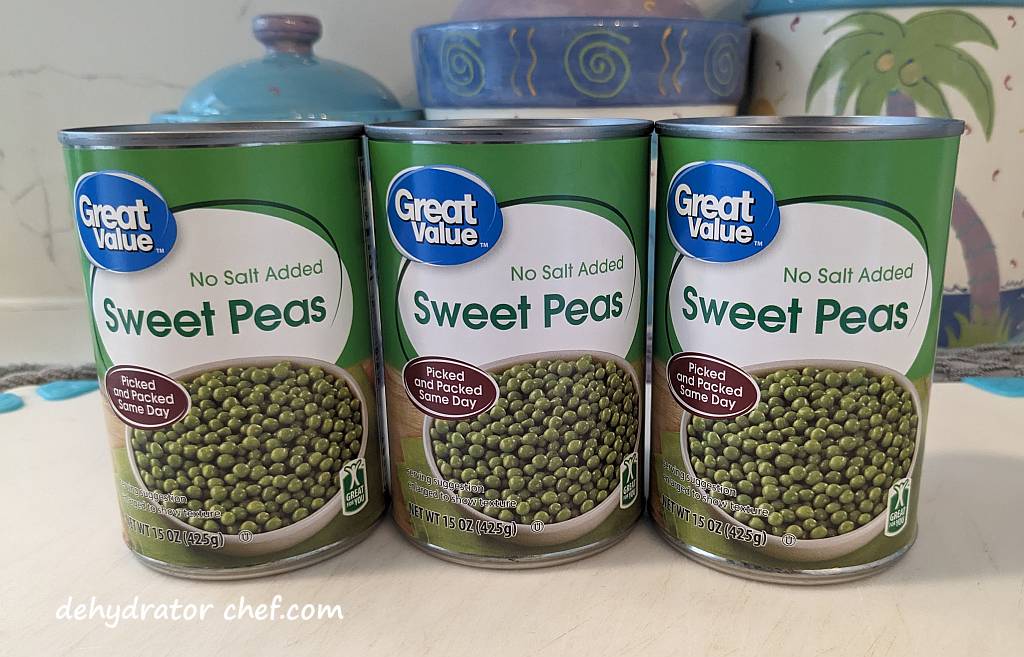
Even if you’ve never dehydrated anything before, don’t worry; dehydrating canned peas is a simple process that anyone can do with just a few basic tools that we will discuss here.
So, whether you’re a seasoned backpacker or just looking to up your camping meal game or stock your preparedness pantry with flavorful options, read on for our comprehensive guide.
So let’s get started dehydrating peas.
Table of Contents
- How to Dehydrate Peas
- Supplies Needed for Dehydrating Peas
- Step 1. Process the Canned Peas for Dehydrating
- Step 2. Preparing the Dehydrator for Dehydrating Peas
- Step 3. Dehydrating the Canned Peas
- Step 4. When are the Dehydrated Peas Done
- Step 5. Equalizing and Conditioning of the Dehydrated Peas
- Step 6. Storing Dehydrated Peas
- Hydration
- Weights, Measures, and Serving Sizes
- Insider Tips
- Conclusion
How to Dehydrate Peas
First, we should talk about dehydrating canned peas versus dehydrating frozen peas. What makes one better than the other, and why?
Our primary consideration is the rehydration time; how long does it take for the dehydrated peas to absorb enough water to become soft enough to eat?
Reconstituting Dehydrated Canned Peas
Canned peas have been cooked. The advantage of using canned peas in our Dehydrator Chef homemade dehydrated camping meal recipes is that they quickly reconstitute at the same rate as other ingredients, typically around 15 minutes.
When vegetables are subjected to heat during the cooking process, the pectin in their cell walls starts to break down. This breakdown of pectin causes the bonds between the cells to weaken, resulting in the softening of vegetables. As the pectin molecules break apart, water is released, further contributing to the soft texture.
Okay, peas are technically a fruit. But I categorize peas as vegetables for dehydration purposes. Maybe I’ll change that later?
The breakdown of the pectin enables cooked and dehydrated vegetables, like peas, to reconstitute much faster than their uncooked counterparts.
Reconstituting Dehydrated Frozen Peas
Frozen peas may have been blanched prior to freezing. They have not been cooked. Sure, we can successfully dehydrate frozen peas. However, reconstituting dehydrated frozen peas into an edible state can take 30 to 45 minutes or longer.
So everything else in the dehydrated camping meal will be reconstituted and ready to eat, except for the peas. This is not what we want.
We know this because we practice making these meals several times at home first, and not trying it for the first time out in the field.
Supplies Needed for Dehydrating Peas
You need a good quality food dehydrator to dehydrate canned peas. We use the Nesco FD-75A, and you can check out our food dehydrator guide here and why we think Nesco offers the best bang for the buck. We believe this is the best food dehydrator for our long-term food storage needs.
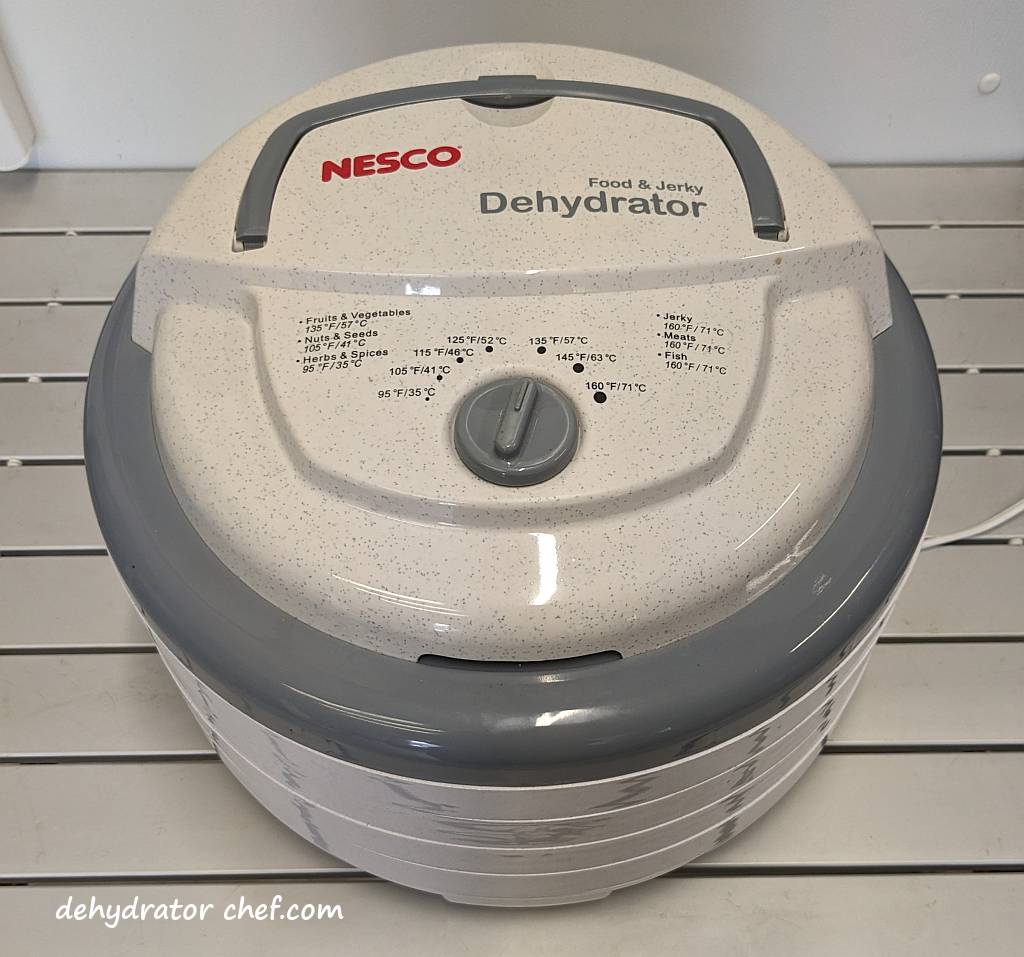
- Several cans of peas
- Colander, for rinsing and draining
- Food dehydrator, with removable fruit roll sheet inserts for the dehydrator trays
- Wide-mouth canning funnel
- Canning jars
For planning purposes, one 15-ounce can of drained peas will fill one of the Nesco FD-75A 13-1/2 inch round dehydrator trays. Three 15-ounce cans worth of dehydrated peas will fill up a single one-pint (16 ounces) canning jar.
Step 1. Process the Canned Peas for Dehydrating
Open the can of peas and empty the contents into a colander. We’ll need to rinse away the canning liquid.
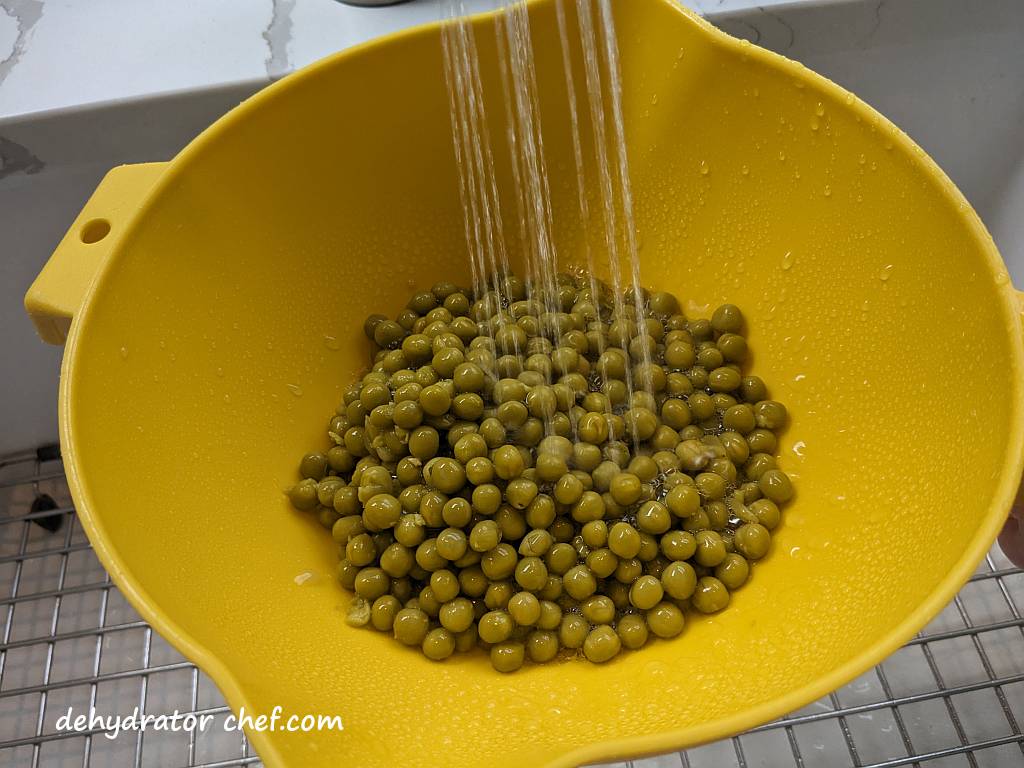
We’re also inspecting the peas for anything that shouldn’t be there.
Step 2. Preparing the Dehydrator for Dehydrating Peas
Evenly spread and layer the peas over the fruit roll sheet inserts. Ideally, only one layer deep. Spread them out for better airflow and faster dehydration. If it’s too crowded, prepare another tray.

One 15-ounce can will fill one of my Nesco FD-75A 13-1/2 inch round dehydrator trays with the removable fruit roll sheet insert.

Spread the peas around the fruit roll sheet into a thin layer to promote even drying.
Step 3. Dehydrating the Canned Peas
For canned peas, set the dehydrator temperature to 135 °F / 57 °C. I find that 18 to 24 hours is about the right amount of time. Use drying times only as a guide. Of course, drying times are variable and dependent on the ambient temperature and humidity, how many, and how crowded you fill your dehydrator trays.
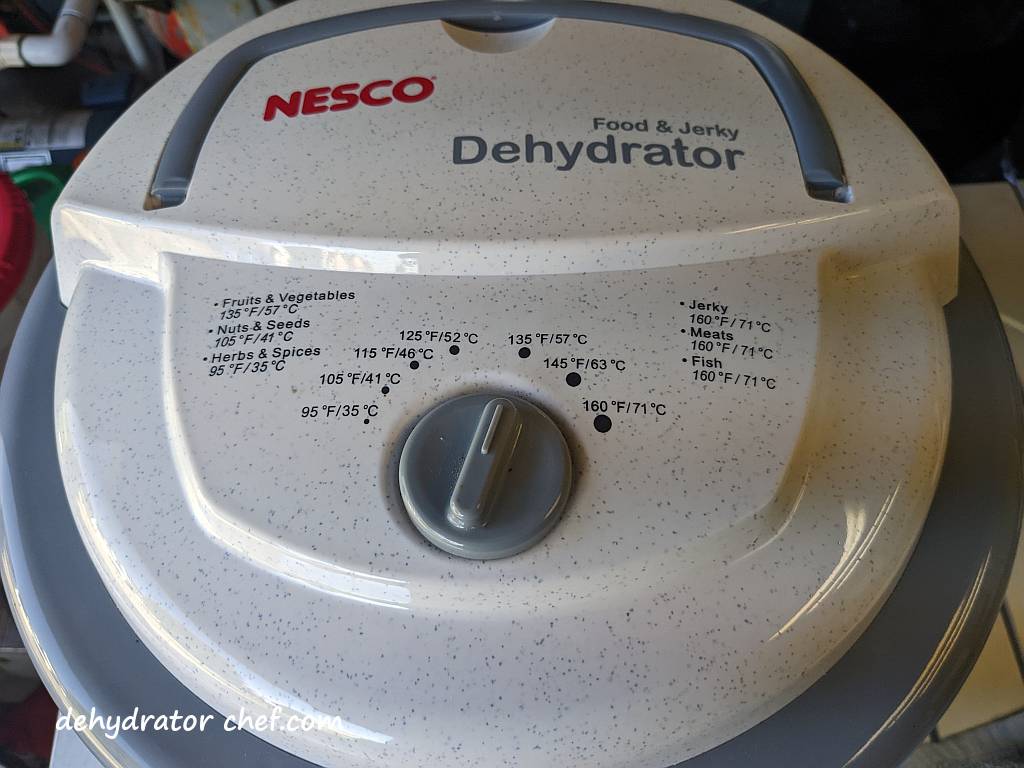
Step 4. When are the Dehydrated Peas Done
The dehydrating peas will tend to shrink up, shrivel, and wrinkle. If not, just let it all go for another couple of hours and check again. They should be hard and puckered when done.

Drying times will vary depending on your dehydrator. Refer to your dehydrator owner’s manual for recommended temperatures and times for dehydrating specific foods. Remember to use drying times as a guide.
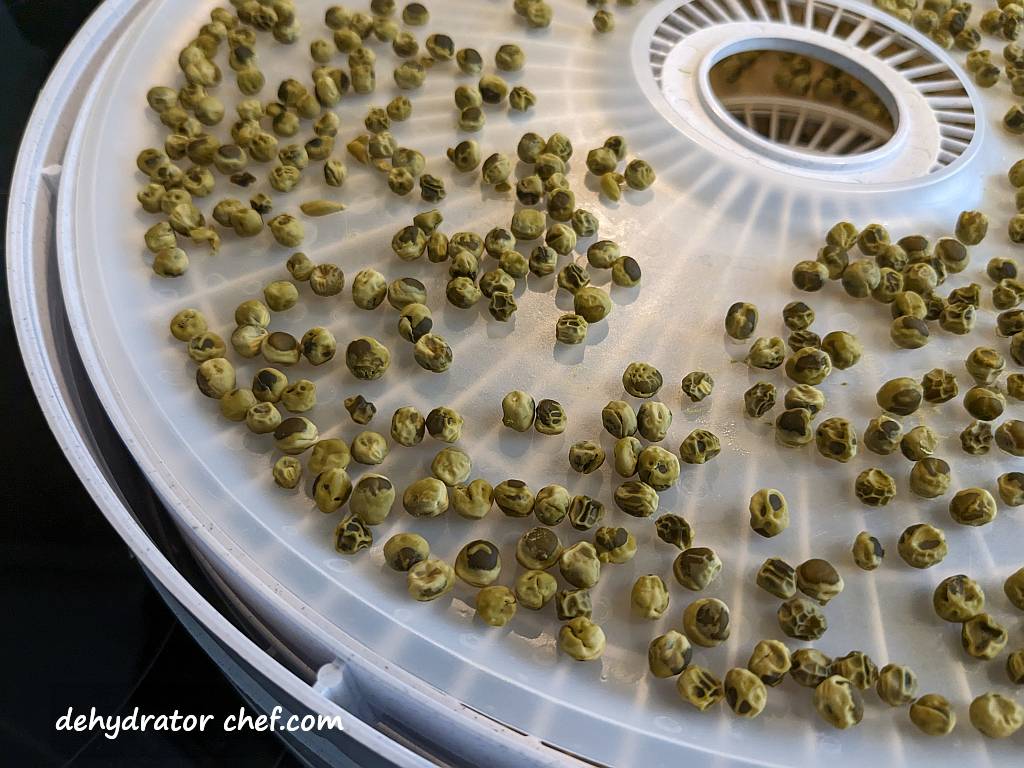
With experience, you’ll develop an eye for this, but until develops, just check it all for dryness.
Step 5. Equalizing and Conditioning of the Dehydrated Peas
We always recommend letting food items cool completely after they have finished dehydrating and before packing them into an airtight storage container for equalizing and conditioning. Warm food may cause sweating, which could provide enough moisture for mold to grow.
It does not take long for dehydrated food items to start hydrating from ambient household humidity. Do not leave dehydrated food items exposed to the elements any longer than necessary because of the increased risk of mold growth.
After a short cooling period, loosely pack the dehydrated peas into a clean, dry, insect-proof, and air-tight storage container. We use the larger quart-size canning jars for conditioning. Since the canning jars are clear, it’s easy to see what’s inside.
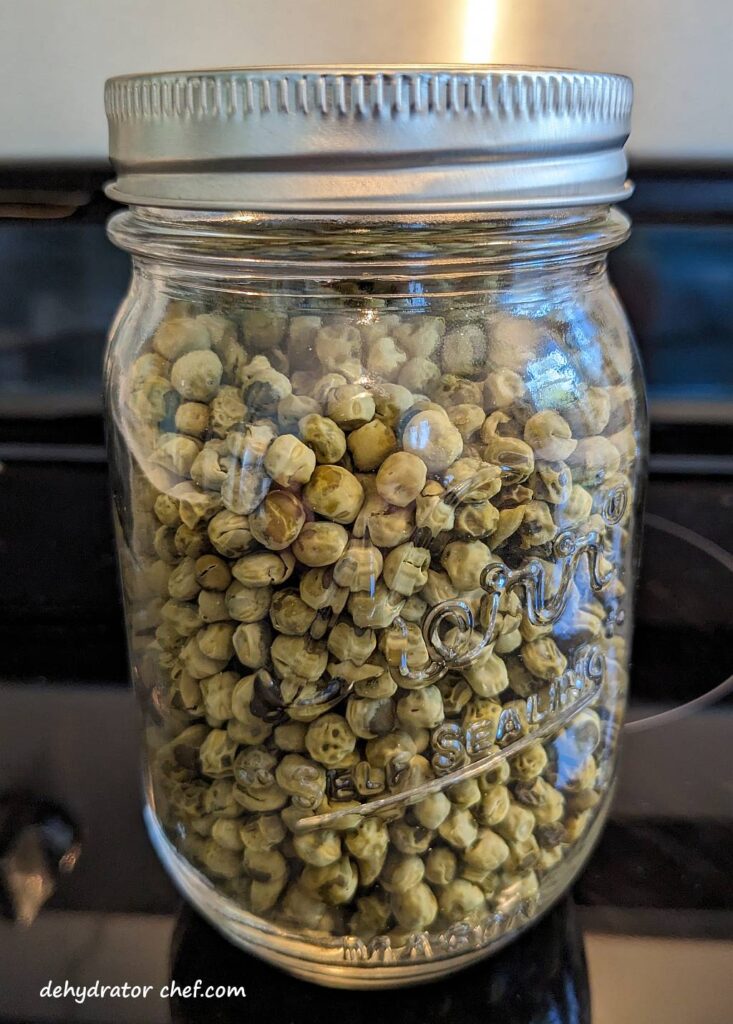
A quality stainless steel or plastic canning funnel makes the messy job of getting dehydrated foods off the dehydrator tray removable inserts and into the canning jars an easy task. Take a minute or two and check them out here on Amazon.
When the dehydrated peas are removed from the dehydrator, the remaining moisture may not be distributed equally among the pieces because of their location and position in the dehydrator. Equalizing and conditioning is a process for freshly dehydrated foods that ensures any residual moisture remaining in any piece is spread, or equalized, among all the other pieces in the batch. Let the dried peas equalize and condition in the storage container for 7 to 10 days.
Every day, check the jar for moisture. Roll the jar contents around and note any clumping or sticking. If seen, put the contents back on the dehydrator for several more hours. Since canning jars are clear, it’s easy to see what’s inside.
In the unlikely event you notice any mold at all, even the smallest bit, throw it all out. What you see are the mold spores finally blooming enough to make them visible. But there are more, even tinier mold spores in the rest of your jar that make your dehydrated food inedible. Toss it out and start another batch.
Step 6. Storing Dehydrated Peas
Use an appropriately sized canning jar for storage. The dehydrated peas might keep up to 12 months or maybe longer. Exactly how long depends on how well you dehydrate the canned peas and your pantry storage conditions.

We’ll use a food-safe desiccant packet for moisture control because we live in a fairly humid area. For our pint-size or quart-size mason jars, we’ll use a single food-safe 5-gram desiccant packet. The desiccant packets will absorb any moisture and extend the shelf life of the dehydrated peas.

We use these inexpensive food-safe desiccant packets which are available from Amazon. These 5-gram packets have over 5000 of mostly 4- and 5-star customer reviews, with an average of 4.7 stars out of 5. Our bag of 60 desiccant packets will last quite a while because they can be recharged and reused multiple times. Other food-safe sizes are available.
Lastly, I’ll attach or include a short note describing the jar contents and the date the product was dehydrated. The note also lets me know where to go in my dehydrator logbook if I want to make another note or two.
Hydration
Hydrate the dried peas using roughly a 3-to-1 or 4-to-1 ratio of dehydrated peas to boiled water. Plan on at least 15 to 20 minutes to fully hydrate.
Weights, Measures, and Serving Sizes
This information is from a recent entry from the notes we keep on most of our food dehydration efforts.
We picked up several cans of 15-ounce cans sweet peas from the big box store.
Rinsed the peas in batches under cold water using a colander.
From the Nutrition Label, one serving size is 1/2 cup. Weight of 1/2 cup of rinsed and drained peas, is 80 grams and we dried on a separate tray.
The dehydrator start time was 08:55, thermostat temperature was set to 135 °F.
Removed from the dehydrator at 07:30 the next morning.
The reserved 1/2 cup of peas, dried, now weighs 13 grams.
Insider Tips
Besides dehydrated meal recipes found here on this website, add dehydrated peas to any of your favorite freeze-dried food pouches for a bit more bulk and calories. I don’t know about you, but with some of those store-bought freeze-dried meals, I am still hungry. I need a bit more to fill me up.
Just be sure to compensate by adding additional boiled water in roughly a 4-to-1 ratio of added dehydrated peas to boiling water to the freeze-dried meal and allow enough time for adequate hydration.
Practice at home making dehydrated camping meals using the very same gear used in the field. We practice reinforcing the skills we have learned. Practice makes perfect.
Conclusion
Dehydrating peas is an excellent way to prepare for your camping or emergency food needs. With this comprehensive guide, you can easily dehydrate peas using the basic tools we have talked about here. Follow these simple steps, and you will have a versatile food source that will last for a long time properly stored in the pantry.
